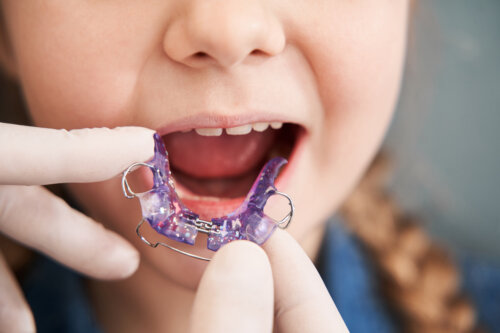The Phases of Orthodontic Treatment in Children


Written and verified by the dentist Vanesa Evangelina Buffa
Orthodontic treatment in children can be divided into different phases, depending on the age of the child and the objective to be achieved. The phases of orthodontic treatment represent critical moments in the orthodontic process and can determine the success of treatment in children.
Early intervention is critical, as the earlier action is taken, the better the results and the simpler and faster the procedures. In this article, we’ll explore in detail the key phases of orthodontic treatment in children, giving you valuable information about each stage and its importance in the development of a healthy, well-aligned smile.

Orthodontic treatment in children
Orthodontic treatment allows the jaws or teeth to be moved in order to bring the oral structures into a harmonious and balanced relationship. With this, the mouth can perform its functions normally and, at the same time, have an aesthetic appearance.
Orthodontic treatments during childhood take advantage of the growth stage of the child to guide and position the jaws and teeth where they belong. This way, a functional bite is generated from an early age. This avoids major complications in the future.
It’s best to start orthodontics as soon as alterations are detected in children’s mouths. In general terms, experts recommend starting therapies around the age of 6.
This type of early treatment is called “interceptive orthodontics” which is an orthodontic approach designed to stimulate and promote optimal development of both the maxillary bone and the jaw.
According to a review article published in Reciamuc Magazine, these approaches seek to prevent and correct occlusion problems, creating an adequate basis for normal jaw development and the eruption of permanent teeth.
This is how pediatric orthodontics allows for the treatment and correction of different bite conditions early on. Crowded teeth, crooked teeth, open bites, crossbites, overbites, narrow palates, and dysfunctional oral habits can be resolved during childhood.
The phases of orthodontics in children
The process of bite correction during childhood consists of several key moments to achieve its specific objectives. In general terms, two main phases of orthodontic treatment in children can be distinguished:
- The first is during mixed dentition, that is, while the child has both milk and permanent teeth in the mouth. This is between 6 and 11 or 12 years of age.
- The second, which may or may not be necessary, is performed several years later. In general, it’s done when the child has completed the eruption of their permanent teeth.
To determine the best orthodontic treatment for your child, the orthodontist makes a thorough study of your child’s case. They use mouth examinations, modeling, x-rays, and photographs to help them evaluate your child’s needs. With this, they plan the procedures to be performed at each stage. We’ll analyze each phase of orthodontic treatment in children in more depth below.
Phase 1 of orthodontic treatment in children
The first phase of orthodontic treatment in children corresponds to the early approach to bite problems and is called “interceptive orthodontics”. It’s performed before the child has all the definitive elements in their mouth.
It’s the application of corrective measures, as soon as an alteration in the occlusion is detected. Also, when it’s presumed that the current conditions of the infant’s mouth will trigger a condition in the future.
Treatments usually begin between 6 and 7 years of age, when the mixed dentition stage begins. However, some cases merit starting earlier or later, when the orthodontist deems it convenient.
Studies published by the Reaciamuc Magazine affirm that interceptive procedures reverse malocclusions or reduce their severity. Therefore, they guarantee the early correction of the child’s bite and increase social and psychological well-being before adolescence.
With these early interventions, major damage is prevented through a simple and fast treatment. The results obtained with interceptive orthodontics may be able to avoid crowding, the need for extractions of permanent teeth, and even mandibular surgeries.

The objectives and timing of interceptive orthodontics
During this phase of orthodontics, the following objectives are pursued:
- Correcting and guiding the growth of the jaws: The growth of the bones is taken advantage of to guide them until they obtain the appropriate size, shape, and relationships.
- Generating enough space for the eruption of the permanent teeth.
- Motivating the elimination of harmful habits: The aim is to banish harmful habits that affect the normal development of the bones or the positioning of the teeth. Thumb sucking, bottle or pacifier use, atypical swallowing, and oral breathing are some examples.
The treatment time for phase 1 orthodontics in children varies between 9 and 18 months, depending on the complexity of the case. To achieve the expected results, the orthodontist uses different types of appliances.
According to a systematic review (Spanish link) of the types of treatments related to interceptive orthodontics in youth and children, all types of skeletal, dental, and esthetic problems can be solved in childhood.
Then, when the desired bite is obtained, a rest period follows. While the definitive teeth erupt, it’s important to use retainers to support the results obtained and to have check-ups every four to six months.
Phase 2 of orthodontic treatment in children
The second phase of orthodontic treatment during childhood isn’t always necessary. Sometimes, the first phase of orthodontic treatment completely solves the occlusion problem. However, in many cases, a second phase of treatment may be necessary.
This second phase involves placing a fixed or removable appliance to complete the bite alignment process. The stage is performed after all the definitive elements erupt in the child, around the age of 12.
If it wasn’t possible to do the first phase of orthodontics during childhood, appliances can be placed at this time. In these cases, the treatment may take longer and require some extra steps.
In general, classic fixed braces with brackets or Invisalign® invisible aligners are used at this stage. This will depend on the child’s preferences and the orthodontist’s recommendations. This phase of treatment can last between 12 to 20 months, although it varies in each child.
The aim is to ensure that each tooth has its corresponding location in the mouth, which generates a harmonious relationship with the lips, cheeks, tongue, and other teeth. This balance allows the teeth to work together correctly.
Once the orthodontist considers that the desired objectives have been achieved, the appliance is removed from the child’s mouth. To sustain the results obtained, the use of fixed or removable retainers will be necessary for a period of time. These attachments keep the bite aligned and prevent the teeth from returning to their previous positions.
Two important moments
Phase 1 and phase 2 of orthodontics with children complement one another:
- After the first phase, the child already has the necessary space for the correct alignment of the permanent dentition. In addition, they have adequate facial harmony.
- Phase 2 appliances are used to improve the results achieved. As a result, improvements in functionality and aesthetics are achieved.
An article published in the Journal of the Romanian Society of Pediatric Surgery indicates that, after the first stage, the child starts the second stage with an acceptable clinical situation. The severity of the malocclusion is less severe and adequate results are achieved at a much earlier age.
Research from the University of Istanbul suggests that early interceptive orthodontic treatments can eliminate the need for more complicated and costly procedures in the future.
Prevention will always be the best option
Preventive corrections during the first stage are able to avoid extractions of permanent teeth or surgical treatments to align the jaws. On the other hand, the second stage allows for functional and esthetic occlusion.
The best time to correct bite problems is during childhood. We recommend that you take your child to the orthodontist from the age of 6. Applying the phases of orthodontic treatment in children when appropriate prevents more severe problems and improves their quality of life.
Orthodontic treatment in children can be divided into different phases, depending on the age of the child and the objective to be achieved. The phases of orthodontic treatment represent critical moments in the orthodontic process and can determine the success of treatment in children.
Early intervention is critical, as the earlier action is taken, the better the results and the simpler and faster the procedures. In this article, we’ll explore in detail the key phases of orthodontic treatment in children, giving you valuable information about each stage and its importance in the development of a healthy, well-aligned smile.

Orthodontic treatment in children
Orthodontic treatment allows the jaws or teeth to be moved in order to bring the oral structures into a harmonious and balanced relationship. With this, the mouth can perform its functions normally and, at the same time, have an aesthetic appearance.
Orthodontic treatments during childhood take advantage of the growth stage of the child to guide and position the jaws and teeth where they belong. This way, a functional bite is generated from an early age. This avoids major complications in the future.
It’s best to start orthodontics as soon as alterations are detected in children’s mouths. In general terms, experts recommend starting therapies around the age of 6.
This type of early treatment is called “interceptive orthodontics” which is an orthodontic approach designed to stimulate and promote optimal development of both the maxillary bone and the jaw.
According to a review article published in Reciamuc Magazine, these approaches seek to prevent and correct occlusion problems, creating an adequate basis for normal jaw development and the eruption of permanent teeth.
This is how pediatric orthodontics allows for the treatment and correction of different bite conditions early on. Crowded teeth, crooked teeth, open bites, crossbites, overbites, narrow palates, and dysfunctional oral habits can be resolved during childhood.
The phases of orthodontics in children
The process of bite correction during childhood consists of several key moments to achieve its specific objectives. In general terms, two main phases of orthodontic treatment in children can be distinguished:
- The first is during mixed dentition, that is, while the child has both milk and permanent teeth in the mouth. This is between 6 and 11 or 12 years of age.
- The second, which may or may not be necessary, is performed several years later. In general, it’s done when the child has completed the eruption of their permanent teeth.
To determine the best orthodontic treatment for your child, the orthodontist makes a thorough study of your child’s case. They use mouth examinations, modeling, x-rays, and photographs to help them evaluate your child’s needs. With this, they plan the procedures to be performed at each stage. We’ll analyze each phase of orthodontic treatment in children in more depth below.
Phase 1 of orthodontic treatment in children
The first phase of orthodontic treatment in children corresponds to the early approach to bite problems and is called “interceptive orthodontics”. It’s performed before the child has all the definitive elements in their mouth.
It’s the application of corrective measures, as soon as an alteration in the occlusion is detected. Also, when it’s presumed that the current conditions of the infant’s mouth will trigger a condition in the future.
Treatments usually begin between 6 and 7 years of age, when the mixed dentition stage begins. However, some cases merit starting earlier or later, when the orthodontist deems it convenient.
Studies published by the Reaciamuc Magazine affirm that interceptive procedures reverse malocclusions or reduce their severity. Therefore, they guarantee the early correction of the child’s bite and increase social and psychological well-being before adolescence.
With these early interventions, major damage is prevented through a simple and fast treatment. The results obtained with interceptive orthodontics may be able to avoid crowding, the need for extractions of permanent teeth, and even mandibular surgeries.

The objectives and timing of interceptive orthodontics
During this phase of orthodontics, the following objectives are pursued:
- Correcting and guiding the growth of the jaws: The growth of the bones is taken advantage of to guide them until they obtain the appropriate size, shape, and relationships.
- Generating enough space for the eruption of the permanent teeth.
- Motivating the elimination of harmful habits: The aim is to banish harmful habits that affect the normal development of the bones or the positioning of the teeth. Thumb sucking, bottle or pacifier use, atypical swallowing, and oral breathing are some examples.
The treatment time for phase 1 orthodontics in children varies between 9 and 18 months, depending on the complexity of the case. To achieve the expected results, the orthodontist uses different types of appliances.
According to a systematic review (Spanish link) of the types of treatments related to interceptive orthodontics in youth and children, all types of skeletal, dental, and esthetic problems can be solved in childhood.
Then, when the desired bite is obtained, a rest period follows. While the definitive teeth erupt, it’s important to use retainers to support the results obtained and to have check-ups every four to six months.
Phase 2 of orthodontic treatment in children
The second phase of orthodontic treatment during childhood isn’t always necessary. Sometimes, the first phase of orthodontic treatment completely solves the occlusion problem. However, in many cases, a second phase of treatment may be necessary.
This second phase involves placing a fixed or removable appliance to complete the bite alignment process. The stage is performed after all the definitive elements erupt in the child, around the age of 12.
If it wasn’t possible to do the first phase of orthodontics during childhood, appliances can be placed at this time. In these cases, the treatment may take longer and require some extra steps.
In general, classic fixed braces with brackets or Invisalign® invisible aligners are used at this stage. This will depend on the child’s preferences and the orthodontist’s recommendations. This phase of treatment can last between 12 to 20 months, although it varies in each child.
The aim is to ensure that each tooth has its corresponding location in the mouth, which generates a harmonious relationship with the lips, cheeks, tongue, and other teeth. This balance allows the teeth to work together correctly.
Once the orthodontist considers that the desired objectives have been achieved, the appliance is removed from the child’s mouth. To sustain the results obtained, the use of fixed or removable retainers will be necessary for a period of time. These attachments keep the bite aligned and prevent the teeth from returning to their previous positions.
Two important moments
Phase 1 and phase 2 of orthodontics with children complement one another:
- After the first phase, the child already has the necessary space for the correct alignment of the permanent dentition. In addition, they have adequate facial harmony.
- Phase 2 appliances are used to improve the results achieved. As a result, improvements in functionality and aesthetics are achieved.
An article published in the Journal of the Romanian Society of Pediatric Surgery indicates that, after the first stage, the child starts the second stage with an acceptable clinical situation. The severity of the malocclusion is less severe and adequate results are achieved at a much earlier age.
Research from the University of Istanbul suggests that early interceptive orthodontic treatments can eliminate the need for more complicated and costly procedures in the future.
Prevention will always be the best option
Preventive corrections during the first stage are able to avoid extractions of permanent teeth or surgical treatments to align the jaws. On the other hand, the second stage allows for functional and esthetic occlusion.
The best time to correct bite problems is during childhood. We recommend that you take your child to the orthodontist from the age of 6. Applying the phases of orthodontic treatment in children when appropriate prevents more severe problems and improves their quality of life.
All cited sources were thoroughly reviewed by our team to ensure their quality, reliability, currency, and validity. The bibliography of this article was considered reliable and of academic or scientific accuracy.
- Campuzano, T. M., Torres, M. F. M., & Rosales, A. M. (2020). Revisión sistemática sobre los tipos de tratamientos relacionados con la Ortodoncia Interceptiva en jóvenes y niños. Revista Científica Especialidades Odontológicas UG, 3(1), 127-131. https://dialnet.unirioja.es/servlet/articulo?codigo=8266791
- Cartes, P. J. G., Piffard, M. J. Z., Donaire, J. A. R., & Padilla, C. D. C. R. (2020). Principales beneficios de un tratamiento de ortodoncia en niños. Reciamuc, 4(1), 333-345. https://www.reciamuc.com/index.php/RECIAMUC/article/view/457
- Geoghegan, F., Birjandi, A. A., Machado Xavier, G., & DiBiase, A. T. (2019). Motivation, expectations and understanding of patients and their parents seeking orthodontic treatment in specialist practice. Journal of orthodontics, 46(1), 46-50. https://journals.sagepub.com/doi/pdf/10.1177/1465312518820330
- Guerrero, C. R., Mancero, O. C., Aráuz, S. M. L., & Macay, R. Z. (2022). Tratamiento interceptivo ortodontico en niños de 9 a 12 años con sobremordida horizontal (mordida profunda). RECIAMUC, 6(3), 326-337. https://reciamuc.com/index.php/RECIAMUC/article/view/912
- İlisulu, C., Uz, S., Koruyucu, M., & Seymen, F. (2019). Early interceptive orthodontic treatments: case series. International Journal of Medical Investigation, 8(3), 104-111. http://intjmi.com/browse.php?a_code=A-10-1-271&slc_lang=en&sid=1
- Oancea, R., Funieru, C., Sfeatcu, R., & Jumanca, D. (2019). INTERCEPTIVE ORTHODONTICS IN PRIMARY AND MIXED DENTITION: THE IMPORTANCE OF EARLY DIAGNOSIS. Jurnalul Pediatrului. http://www.jurnalulpediatrului.ro/magazines/87-88.pdf#page=18
- Torres, F. O. L., & Illescas, M. V. L. (2023). Importancia del tratamiento oportuno en ortodoncia: Revisión bibliográfica. Domino de las Ciencias, 9(2), 516-532. http://dominiodelasciencias.com/ojs/index.php/es/article/view/3227
This text is provided for informational purposes only and does not replace consultation with a professional. If in doubt, consult your specialist.








